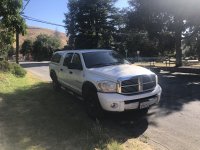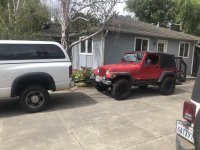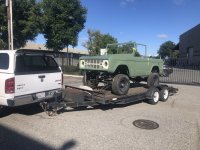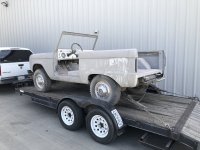Community
Message Forum
Photo Gallery
Event Calendar
Book Reviews
Bronco Wallpaper
Bronco FAQ
Link Back to CB!
Photo Gallery
Event Calendar
Book Reviews
Bronco Wallpaper
Bronco FAQ
Link Back to CB!

Buy / Sell



Bronco Tech
3 Arm Wiper Setup
Fix Motor Mount
Roll Cage Braces
Throttle Body 65mm
Wheel Alignment
Heat Riser Replacement
Vent Window Repair
Center Console Mount
Straighten Bumper
Ford 6R80 6 spd
More Tech...
Fix Motor Mount
Roll Cage Braces
Throttle Body 65mm
Wheel Alignment
Heat Riser Replacement
Vent Window Repair
Center Console Mount
Straighten Bumper
Ford 6R80 6 spd
More Tech...

Install the app
-
Welcome to ClassicBroncos! - You are currently viewing the forums as a GUEST. To take advantage of all the site features, please take a moment to register. It's fast, simple and absolutely free. So please join our community today!If you have problems registering or can't log into your account, please contact Admin.
You are using an out of date browser. It may not display this or other websites correctly.
You should upgrade or use an alternative browser.
You should upgrade or use an alternative browser.
Dana 44 inner c cut and turn
- Thread starter widowmaker77
- Start date
No cross caster here. Same reasoning as Yeller. I'm at 6° of caster, give or take a 10th.Do you all just make each side the same every time? Or does anyone ever add cross caster?
Or is that just not a thing anymore?
On a side note, a few years ago I bought some eccentric upper ball joint sleeves, with the intent of using them to take out the visibly noticeable positive camber, which was a bit over 1.5° per side. Note that those things can affect caster or camber or both, depending on how they are adjusted. In my case I went for pure camber and took out most of it. I don't have an "after" alignment readout handy, but I got it within a few 10ths of zero. And other than reduced wear on the outer part of the front tire tread, didn't really notice a difference. I think I used 1.5° eccentrics but again don't have evidence of that at my fingertips either.
When I did mine 20-something years ago I was mostly clueless about the whole task even though I'd thought about it a lot. I too was setting my D44 to work in my Bronco. At the time I had 7° C bushings and even eccentric upper ball joint sleeves installed, trying to get enough caster. With the 3-1/2-ish inch front coils I had at the time, the alignment shop still only measured around 2° on one side and 1.5° on the other.Yup. But you have to think about things a LITTLE. When you cut thru the inner C welds, you don't want to go too deep into the axle tube, but you do have to get thru the weld. Also, the inner C to tube is an interference fit, and they don't just fall off. You will need to persuade them to move. Which means that the axle housing itself moves around a lot.
So if the axle were bolted down so it couldn't move, then yes...just cut thru the welds and roll it back. But the axle will flop around, and the inner C will be stubborn, AND if you remove both sides then you lose your reference. (because your other inner C got moved)
I also don't like to play around with my protractor very much, so I set the inner C at dead level, and roll the pinion to the desired angle. (which is the desired pinion angle plus your 6-7 degrees of caster) It's a PITA to set one side caster at 7, move to the other side, try to roll that side to reach 7, swat it with a hammer, and have the protractor fall off the housing as the housing falls off the stands.
I used a nifty idea from @ntsqd to make a simple tool that allowed me to first measure the "before" caster and later to align things side to side.
With the Bronco on jack stands at ride height and a friend helping me, we removed the eccentrics and replaced them with stock sleeves, then used a protractor to measure the caster. The hope was that we would measure about 1.5° less than the alignment shop readout, since supposedly the eccentric sleeves had added that much. That turned out to be the case, so we proceeded to swap the 7° bushings for 2° bushings (since that was what I was planning to use) and measured again. That gave us a starting point caster value and informed us of how much we would need to rotate the inner C's to get my desired 5° of positive caster (yes, 6 is better but I didn't grasp that at the time). I don't recall the exact number but it was a lot- more than 10° of rotation was going to be required.
Out came the axle, off to the shop at work and fired up the carbon air-arc gouger. Nice to have a ginormous rotary screw compressor available. Using the nifty tool set, we used the protractor to check side to side again, sure enough one was 0.5° off from the other. Then used a BFH and some heat to persuade the first C. Kept going until the delta between sides matched the goal. Tacked that one back in place. Not that it was likely to move on its own but you can't be too careful. Off to the other side, repeat until we drove the side to side delta to zero. And for good measure, we eyeballed the two long rods and we both agreed they were parallel.
With everything back together, off to the alignment shop (and these numbers I remember because I was so amazed). One side was 5° on the money, the other was 5.1°. Good enough.
A few years later I extended my radius arms 6 inches, which added another degree. Rotated the pinion down too, which might've been a bad thing except I also swapped my N435 for an NV4500 + Atlas and the lowered pinion serendipitously worked out just right
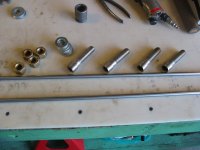
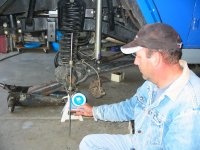

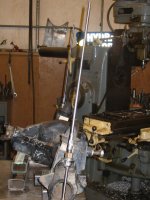
The "nifty tool" is just a pair of verified-straight steel rods, and four socket head cap screws drilled to a close fit with the rods, and heads turned down so they could snug up inside the lower taper of the inner C and the (reinstalled) upper ball joint sleeve. Nuts and washers to retain them, bit o' duct tape to keep the rods from sliding around.
All in all a lot of work. Worth every minute of effort. Are there better ways? No doubt. Including paying someone else to do it. But this worked for me back in 2003.
Last edited:
ntsqd
heratic car camper
Jeez, it been a moment or two since then. Who has that tool now?
oh, yeah, the right sized o-ring would keep those drill rods from sliding thru the modified bolts. And look way cooler than some duck tape.....

oh, yeah, the right sized o-ring would keep those drill rods from sliding thru the modified bolts. And look way cooler than some duck tape.....
I have been wondering the same thing, but it just occurred to me that I believe the answer is "I do." Hidden in plain sight. If I'm not mistaken I've been looking at it for years, bits are in a piece of white PVC pipe with end caps stuck on it, residing in one of my scrap metal bins. Gonna check next time I get over there. Which won't be today or tomorrow, given the heat forecast.Jeez, it been a moment or two since then. Who has that tool now?
oh, yeah, the right sized o-ring would keep those drill rods from sliding thru the modified bolts. And look way cooler than some duck tape.....

And good point about the o-rings.
jamesroney
Sr. Member
@DirtDonkWhen roads were primarily 2 lane, cross caster made sense, road is crowned so you're always drifting right. Now that so many roads are multi lane and divided, they are still crowned but you drive on both sides of the crown, so you are drifting both ways depending on which lane you are in. So IMHO the theory of cross caster is great in theory, it is no longer relevant as the roads have changed.
I always put a little bit of extra cross caster in the left knuckle. I do it to ensure that I don't accidentally put cross caster the wrong way, so I always bias it towards the road crown.
I don't suppose it actually makes much difference which way you bias the cross caster, as long as it is always tugging on the tie rod. I just don't want it neutral where it's going thru the inflection between pulling and pushing. Plenty of witchcraft and voodoo in the theory, and I admit that it might be superstition. But I've had pretty good luck so far.
The majority of my Bronco driving is on a 2 lane. If I'm running on a divided multi-lane interstate...my Cummins is dragging the Bronco and I'm getting 23MPG of air conditioned luxury.
So I'm going to agree with @Yeller, but also disagree a little. Theories are funny things. In theory, I am a millionaire lounging on the beach. But in reality...I'm here with you. So there's that.
And I want to see that Cummins 
I've owned a fleet of them and only 2 would pull that empty, never towing. Probably a new thread is needed for that LOL
I've owned a fleet of them and only 2 would pull that empty, never towing. Probably a new thread is needed for that LOL
jamesroney
Sr. Member
Looks like every other 2006 megaCab with the 5.9 24V. Drove it from Fremont to Ice House campground (Rubicon) dragging that TJ just last month. 23.1 mpg on the “lie-o-meter”And I want to see that Cummins
I've owned a fleet of them and only 2 would pull that empty, never towing. Probably a new thread is needed for that LOL
Works on Bronco’s too.
Attachments
jamesroney
Sr. Member
Well, yeah! Your F550 gets thirsty. But you are basically rolling real estate. I’m pretty sure that the asphalt is squirming out from under your tires!I obviously need a different tow rig if you are getting 23mpg while towing.

(Yeah, I’m jealous…)
ntsqd
heratic car camper
Going thru an inflection point is kind of like dividing by Zero. Just avoid that as much as possible.
I've learned that the key to mileage with our correctly valved 6BT is how I drive it. Drive it like a gasser and I get 13-ish. Drive it with the same throttle setting that puts it in it's sweet spot RPM-wise when on flat-level-no wind and I have gotten 18-20 on metric 35's and with the camper in the bed. The last time that I did this was going North over the Grapevine. Sure is boring to drive that way and SWMBO wonders wtf I'm doing.....
I've learned that the key to mileage with our correctly valved 6BT is how I drive it. Drive it like a gasser and I get 13-ish. Drive it with the same throttle setting that puts it in it's sweet spot RPM-wise when on flat-level-no wind and I have gotten 18-20 on metric 35's and with the camper in the bed. The last time that I did this was going North over the Grapevine. Sure is boring to drive that way and SWMBO wonders wtf I'm doing.....
- Joined
- Jul 31, 2001
- Messages
- 9,300
I would have loved to have gotten an F450, but no way am I gonna roll down the highway all the time with almost two thousand pounds over GVWR limit, just on the truck!
I know guys with the 4500 series and have a 7K lb camper plus 1K tongue weight.
Just thinking liability...
I know guys with the 4500 series and have a 7K lb camper plus 1K tongue weight.
Just thinking liability...
Not t mention having DOT hammer you with fines for not having your “tag” at the proper weight. At least in MS that’s the case.[ but no way am I gonna roll down the highway all the time with almost two thousand pounds over GVWR limit, just on the truck!
Just thinking liability... ]
When I got a tag for a 1-ton Dodge diesel to pull a 35’ gooseneck camper, the tag/tax peeps told me that the 18,000# tag would NOT be enough…and if DOT ticketed me for tag weight violation it would be way more than the cost if going to a 22,000# tag.
Y’all may not have such a draconian DOT and your tag weight may not matter.
Randy
jamesroney
Sr. Member
Yup, all true. And if you modify the bed in CA, you must stop at the scales EVERY time. If you change the vehicle classification to a motor coach, then you can dodge the weight fees, and the scales. (DOT isn’t really looking for @nvrstuk ). They are looking for easy, reliable revenue.Not t mention having DOT hammer you with fines for not having your “tag” at the proper weight. At least in MS that’s the case.
When I got a tag for a 1-ton Dodge diesel to pull a 35’ gooseneck camper, the tag/tax peeps told me that the 18,000# tag would NOT be enough…and if DOT ticketed me for tag weight violation it would be way more than the cost if going to a 22,000# tag.
Y’all may not have such a draconian DOT and your tag weight may not matter.
Randy
Once you are a motor home, you can build your coach suspension with rubber bands and conduit. In CA, you can declare yourself homeless, and you won’t get parking tickets either.
TheLimeRanger
Sr. Member
- Joined
- Sep 5, 2001
- Messages
- 760
so if im currently at 1.6° and 1.8° with a 2.5" lift and 7° c bushings and rotated the C's 10° and used 2° bushings would i theoretically be at 6.6° an 6.8°? and if so, is that too much? thx
Sounds about right. And no, not too much.so if im currently at 1.6° and 1.8° with a 2.5" lift and 7° c bushings and rotated the C's 10° and used 2° bushings would i theoretically be at 6.6° an 6.8°? and if so, is that too much? thx
jamesroney
Sr. Member
I’ve never seen a factory 44 with 7 degree c-bushings and 2.5 lift sitting at 2 degrees. So I’m a skeptic.Sounds about right. And no, not too much.
You never saw mine. 1977 Dana 44. 3-1/2" nominal spring lift. 7 degree bushings. 1.5 degree "caster correctors." Less than 2 degrees of measured caster. Tried multiple sets of C bushings, three different alignment shops. I may still have a printout somewhere. It's what led me down the road to the fix I described in a previous post. Yes, it was that bad.I’ve never seen a factory 44 with 7 degree c-bushings and 2.5 lift sitting at 2 degrees. So I’m a skeptic.
Not trying to be an ass, James. 21 years ago when I was feeling desperate and had discovered that my boss's 78 Bronco had 6 degrees of measured caster and drove great, I realized I wasn't going to get there with bandaids. I have the deepest respect for everything you've posted about this. I was flying blind, grateful that it worked out as well as it did. Learned a thing or two.
- Joined
- Jul 31, 2001
- Messages
- 9,300
I remember when you posted about doing this "C" bushing correction mod. I was kinda shocked at the time that someone would go thru that much effort to fix their caster! Mine was never that bad and I was really glad at the time that I didn't need to do what you did to get it to handle decently! That was before the 1st Rubicon meeting correct?You never saw mine. 1977 Dana 44. 3-1/2" nominal spring lift. 7 degree bushings. 1.5 degree "caster correctors." Less than 2 degrees of measured caster. Tried multiple sets of C bushings, three different alignment shops. I may still have a printout somewhere. It's what led me down the road to the fix I described in a previous post. Yes, it was that bad.
Not trying to be an ass, James. 21 years ago when I was feeling desperate and had discovered that my boss's 78 Bronco had 6 degrees of measured caster and drove great, I realized I wasn't going to get there with bandaids. I have the deepest respect for everything you've posted about this. I was flying blind, grateful that it worked out as well as it did. Learned a thing or two.
I was driving mine to work every day so I couldn't imagine getting all that work done in a weekend either!
Great job pioneering that mod that many years ago Lars!
TheLimeRanger
Sr. Member
- Joined
- Sep 5, 2001
- Messages
- 760
i was skeptical also. i thought for sure those bushings were in backwards, or they werent 7° bushings, so i took it apart, they were in right and they were 7°. I just drew the short straw on the dana 44. the guy welding it probably did it on a friday at 4:45 and wanted to get the hell out of there! ive reached the point where ive had enough of it driving like crap, now i just need to find someone to do it. i dont have the skillset to take this on myself. i know where this goes though, well, while im doing this, i might as well go to an overdrive transmission, and if im going to do that, might as well change the gear ratio's lol. i need to focus!I’ve never seen a factory 44 with 7 degree c-bushings and 2.5 lift sitting at 2 degrees. So I’m a skeptic.
Similar threads
- Replies
- 4
- Views
- 504
City: Tomah, WI
Price: $250
- Replies
- 0
- Views
- 337







